|
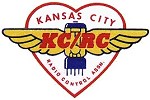 Kansas City Radio Control Association (KCRC)
has been around for many decades. Its AMA club number of #390 was assigned in 1954. That
was 66 years ago as of this writing, but it was only 8 years old when this feature
article appeared in American Modeler magazine. Since at least 1962, the
KCRC flying field (now named "Charles W. Reed III Flying Field")
has been located just west of Lake Jocomo, in Kanas City. This article discusses not
just the KCRC flying site, but many of the others in the surrounding area. I count 11
on the included map, including parks, schools, and parking lots. It is interesting to
compare the maps of Kansas City from 1962 to the same area on the current
Google Map. It appears parts of the Missouri River has been
modified to accommodate city development. Kansas City Radio Control Association (KCRC)
has been around for many decades. Its AMA club number of #390 was assigned in 1954. That
was 66 years ago as of this writing, but it was only 8 years old when this feature
article appeared in American Modeler magazine. Since at least 1962, the
KCRC flying field (now named "Charles W. Reed III Flying Field")
has been located just west of Lake Jocomo, in Kanas City. This article discusses not
just the KCRC flying site, but many of the others in the surrounding area. I count 11
on the included map, including parks, schools, and parking lots. It is interesting to
compare the maps of Kansas City from 1962 to the same area on the current
Google Map. It appears parts of the Missouri River has been
modified to accommodate city development.
Sites Are Great in Kansas City
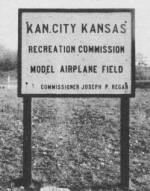 Ever have some teacher scoop up a half-finished
airplane drawing from behind your geography book with the comment, "There's a time and
a place for everything?" Ever have some teacher scoop up a half-finished
airplane drawing from behind your geography book with the comment, "There's a time and
a place for everything?"
Kansas City - Missouri and Kansas - modelers would agree that this teacher had the
right idea, even for modelers who are "site dreaming." K.C. clubs feel that the proper
time and place had a great deal to do with their acquisition of flying facilities.
Take first the story of the R/ /C boys.
In the spring of 1960 the Kansas City Radio Control Association had just lost a pasture
flying site north of the Missouri River to a church project. Having no alternate site,
the KC/RC'ers took to their cars. Operation "Sight-a-Site" was on.
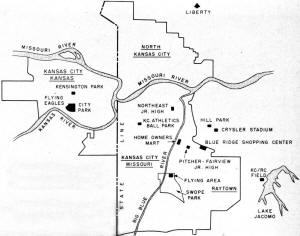 On one of these jaunts, Bud Atkinson, then club
president, and side-kick, Carl Lindsey, found themselves in a park being developed around
Lake Jacomo, east of Kansas City, Mo. They spied a clear, flat hilltop, unloaded their
models and flew them a few times. No radio interference! Could this be it? On one of these jaunts, Bud Atkinson, then club
president, and side-kick, Carl Lindsey, found themselves in a park being developed around
Lake Jacomo, east of Kansas City, Mo. They spied a clear, flat hilltop, unloaded their
models and flew them a few times. No radio interference! Could this be it?
A few days later, joined by Max Boal, another veteran KC/RC'er, they approached William
L. Landahl, director of the Jackson County Park Department, and asked him for use of
this space for a flying field.
Their timing, luckily, was perfect-the area had not yet been designated for any other
use. The park department granted their request and agreed to mow out a runway. Many of
the KC/RC members were using multi equipment and desired a paved runway. Landahl said,
"Let's wait and see if the actual usage warrants permanent improvements."
So, the KC/RC showed 'em. The park authorities were impressed. However, at that time
there were no funds for improvements. They did promise to help on a surfacing project
with the park grading and rolling equipment.
Because of a lean treasury, the KC/ RC'ers felt they had to get the mostest for the
leastest, so they decided on a rock dust field bed with motor oil topping. Rock dust,
a by-product of quarries which grind gravel, is obtainable almost for the cost of hauling.
Used motor oil can be collected free from some service stations.
Rock dust runway has been oiled into smooth surface.
A 175 x 35-foot N-S strip was laid out, then prepared by the park department. Club
members pitched in to smooth out the dust spread by the dump truck. A few rains, plus
125 gallons of motor oil and more rolling set the surface up just right for flying. Most
of the motor oil was obtained by Charles Reed, Ward Hunter and Dick Weathers, who sprinkled
it over the field the hard way - with flower watering cans.
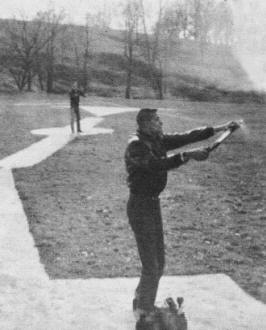
Bill Tate helps John Holliday at K.C., Kan., modelport; note rail
fence behind sign (left).
That summer the club held its annual contest at the site, drawing 40 contestants and
2,000 spectators during the two-day affair.
The progress of the flying site project was well covered by the club newsletter, "KC/RC
Contacts," edited by D. C. Stephens. Stephens also printed and distributed five-color
KC/RC decals.
The club's first runway worked out so well that the fall of 1961 found them adding
a 200 x 35-foot diagonal strip to their field layout. The same construction procedure
was used. Cost of the two strips was around $200, paid largely by member donations.
"We realize we were lucky," says Atkinson. "Most of the developed park space has now
been designated for specific use. In fact, the park recently published an official map,
we felt real good when we saw our space marked on it as the 'radio controlled model plane
flying area'."
Another Kansas City club which feels that timing is often a vital factor in site acquisition
is the Flying Eagles of Kansas City, Kans., a control-line outfit, with an improved site
at City Park.
They struck pay dirt in 1956 when the city administration changed. Before that they
had talked with the recreation and parks departments and mayor but had never found a
really attentive ear.
Then, Paul Mitchum was elected mayor.
He is a friend of Charles Wilson, a local hobby dealer; when approached by Wilson
and Bryon Meriwether of the Flying Eagles, he listened long enough to see that the modelers'
request was reasonable and need not be too expensive. He asked the park department to
try and help them.
Given this push, the park department found a spot in City Park that could be made
usable by chopping off part of a hill. Luckily this plot of 800 square feet was just
across the way from the department's equipment barns. The park equipment operators were
instructed to "go over and scrape down that hillside some whenever you come back to the
barn a half-hour or so early." Eventually, they had space made and leveled for a circle.
Then they hauled in a quantity of broken brick for filler and about 60 bags of cement
and proceeded to put down a paved center, eight feet in diameter, for the circle and
two take-off strips, 20 x 50 feet.
The area was finished by the erection of a rail fence and the seeding of the bare
spots to bluegrass. Then a sign reading, "Kansas City, Kans., Recreation Commission,
Model Airplane Field, Commissioner Joseph P. Regan" was erected and the model port was
officially opened.
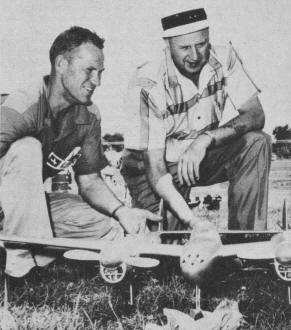
Hiz Honor Mayor Paul Mitchum of K.C., Kansas (wearing hat, left) gets
lowdown on P-38 via Al Houpt. Mayor Mitchum put bee on city park department to provide
Flying Eagles with U/C site at City Park.
The Flying Eagles annually hold two open contests at this site, and the circle is
used extensively for practice and sport flying. The Eagles have developed several consistent
contest winners, with 12-year-old Wayne Meriwether probably heading the list with over
100 trophies to his credit.
Park personnel noted that at least 100 modelers, many without club affiliation, are
using the site, and that there are often waiting lines. So, work is in progress to scrape
off more dirt from the hillside to make room for a second flying circle, The progress
is slow because dirt is moved only as it is needed for fill elsewhere.
The Flying Eagles' can thank the park department for a bi-monthly meeting place at
the community center building in Kensington Park.
A third flying site, shared by several Kansas City, Mo., control-line clubs, is the
asphalt parking lot of the Home Owners Mart, a large discount store. The store has made
this space available every Sunday, requiring only that the flying area be roped off,
that all flyers have A.M.A. licenses and that combat flights be confined to official
contests.
Phillip Cloe of the Sky Devils carried the load in negotiations for this site. He,
too, is a firm believer in the importance of timing. A ruling by the Missouri Supreme
Court in the fall of 1961 brought about a revival of the strict enforcement of the old
"Sunday blue laws," which permits only necessities to be offered for sale. Many large
stores, H.O.M. included, began closing on Sundays.
Cloe saw all the H.O.M. parking area going to waste for a few Sundays, then approached
Glen Moore, H.O.M. manager, with an idea. "Why couldn't the modelers use the lot?" Moore
liked the suggestions and after clearing it with H.O.M. general manager, Herb Kaufman
and president, T. Goodwin Lyon, drew up a notarized agreement with the modelers freeing
the store from any possible damages.
A fourth control-line site used by the Sodbusters, Sky Devils and Jackson County Prop
busters is at Swope Park, where a grass area is set aside for model flying. There is
space here for 6 to 8 circles.
Prop busters also have permission to use the school grounds at Pitcher-Fairview Junior
High. Sodbusters are allowed the use of a spot at Northeast Junior High.
The Flying Fools Model Club, concentrated more in the Independence and Raytown areas,
also uses school yards and baseball parks where they have permission to fly when the
areas are not otherwise in scheduled use.
Both Jackson County Propbusters and Flying Fools have members interested in indoor
flying and free flight. For microfilm meets they have been granted the use of school
and church educational building gyms, for the latter they depend upon pasture land.
Another club, the Winged Motors, a flight outfit spearheaded by the Carl Perkins family,
is perhaps the farthest traveling group of all when it comes to flying sites, depending
mostly on the pastures of friendly farmers.
Thus, although modelers have made gains in the site situation in and around Kansas
City, there are several clubs who still have a big need for better facilities.
This requirement was one of the factors which lead to the organization of the Kansas
City Model Association in the fall of 1960. The Association is composed of Kansas City
area model clubs and hobby dealers. Originally, the clubs called a joint meeting to formulate
better plans for contest scheduling. Preliminary sessions quickly emphasized need for
more flying sites and for better publicity which might help in their acquisition.
With these three-fold aims, the K.C.-M.A. has been making itself heard during the
past 18 months. First, in 1961, they combined talents, materials and funds to set up
a modeling display at the Kansas City Municipal Auditorium during the annual Sports and
Hobby Show.

KCRC'ers at Jacomo Park field in Missouri.
Secondly, they organized a demonstration flying team which performed at the Kansas
City Athletics' stadium between games of major league double-headers, at a civic celebration
in Iola, Kansas, and at a large air show at East Kansas City Airport. Also, they improved
the contest scheduling of the various clubs, especially for small unsanctioned meets,
and helped each other out with manpower for judging competitions. The Association itself
has sponsored a U-C meet at the Flying Eagles field and a F.A.I. Indoor Elims at the
Olathe (Kans.) Naval Air Station.
Two K.C.M.A. members have given considerable time to encourage junior modelers. Jim
Dunkin of the Propbusters and Paul Woodford of the Sky Devils served as instructors for
modeling classes at the Kansas City Boys Club. Another assist to the juniors was furnished
by the Propbusters who established "help day" at Hill Park in Independence for boys with
plastic ready-to-fly models as well as other beginners.
K.C.M.A. flyers have found that they draw unexpected strength from each other's experiences,
as exchanged at the monthly association meetings. Another prodding and unifying factor
in the success of the K.C.M.A. has been the regular association reports in the "Slipstream,"
newsletter of the Jackson County Propbusters, edited by Dick Black. Dick's "Prop Wash"
column has snapped numerous fingers and suggested improvements that could be made.
When Dick moved to Omaha, Nebr., this spring, the K.C.M.A. took over the publication
of "Slipstream" as an Association project. Bill Wright, president of the Sodbusters,
is serving as editor, and each club contributes news of its activities. Another major
project for 1962 is the staging of a big A.M.A. sanctioned contest.
Other big affairs in the Kansas City area include the annual Heart of America Control-line
Meet sponsored by J. J. Newberry's and held on the parking lot of the Blue Ridge Mall
Shopping Center, near the Newberry store. Various contest directors of the K.C.M.A. help
with this meet, which offers 22 trophies and $600 in merchandise.
Another is the Flying Fools' Tri-State Model Air Contest, co-sponsored by the Independence
Junior Chamber of Commerce, and held at Crysler Stadium in Independence.
Many in the Greater Kansas City area have become active in F.A.I. team racing. Bob
Watts of Liberty and Claude Adams of Raytown went to Budapest in 1960 as members of the
U.S. Internats team. Jim Dunkin and Steve Bard just missed a berth on the 1962 U.S. team
when Dunkin's engine conked during the 99th lap of a F.A.I. Elims at Wichita, Kans.,
last fall.
"Being a contest-minded group, the K.C.M.A.'ers hardly ever meet without some discussion
of getting a flying site of their own which can be improved," says L. V. Underwood, association
president. They have made many inquiries and filed letters with the city park department
and elsewhere.
To date, the perfect spot hasn't been found, but they feel certain that a unified
approach in time will lead them to something. For Kansas City modelers are definitely
taking off on an expanded program of modeling activities.
Posted January 20, 2018
|


